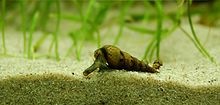Needle Crown Snail
| Needle Crown Snail | ||||||||||||
|---|---|---|---|---|---|---|---|---|---|---|---|---|

Needle crown snail ( Melanoides tuberculata ) |
||||||||||||
| Systematics | ||||||||||||
|
||||||||||||
| Scientific name | ||||||||||||
| Melanoides tuberculata | ||||||||||||
| OV Müller , 1774 |
The needle crown snail ( Melanoides tuberculata ), usually called the Malay , Malay or Indian tower snail in the aquarium hobby , is a freshwater snail that is native to East Africa to Southeast Asia , but is now also found in Europe as a neozoon .
features
These snails have a tower-like coiled shell up to three centimeters in size and one centimeter wide with usually eight to 15 turns. Breathing occurs through gills . The coniferous crown snails are nocturnal and prefer to stay in the ground during the day. The animals are separate sexes , but reproduce mainly through parthenogenesis . They are viviparous and reproduce quite quickly under favorable conditions. The number of young animals varies, depending on the size of the mother animal, between one and up to five young animals, which - also depending on the size of the mother animal - are between 1.5 and a maximum of 4.3 mm in size.
Invasive nature and role as intermediate host for parasites
As an aquarium snail, the needle-crowned snail was introduced into fresh waters on the Gulf of Mexico , where it has been recorded since 1952. As an invasive species , it displaces local snails in the same biotope . A major problem for humans and livestock is that it also serves as an intermediate host for various flukes , including lungworms , which are transmitted via crabs as a second intermediate host to birds or to mammals, including humans.
Aquarium keeping
In the hunting these animals are widely used because they are often relatively to plants are from pet shops and so unintentionally in many aquariums go. However, they are also used specifically in tanks, as they loosen the soil and feed on food and plant residues. Healthy plants will also be eaten if they are excessively stocked. The snail can often be seen in the aquarium during the day when the company is quiet, for example with other snails or dwarf shrimp . In lively society and with very fine-grained substrates, however, it is mainly found in the substrate and is mainly visible at night. These snails are a good indicator of water quality. If they appear more often during the day or even strive towards the surface more frequently on the pane, this can indicate poor water quality ( nitrite, etc.).
Parasites
The needle crown snail can harbor various endoparasites. In 2011, Pinto and de Melo compiled a list of 37 species of trematode that can infest the snail. Eleven of these trematodes are also pathogenic to humans:
- Chinese liver fluke Clonorchis sinensis
- Centrocestus formosanus
- Paragonimus westermani - Oriental lung fluke
- Paragonimus kellicotti
- Rat lungworm Angiostrongylus cantonensis
- Loxogenoides bicolor
- Transversotrema laruei
- Sticiodora tridactyl
- Gastrodiscus aegyptiacus
- Philophthalmus gralli
- Philophthalmus distomatosa
- Haplorchis pumilio
- Haplorchis sp.
- Metagonimus
- Diorchitrema formosanum
- undifferentiated species of pair leeches (Schistosomatidae)
Web links
- Melanoides tuberculata inthe IUCN 2013 Red List of Threatened Species . Posted by: Madhyastha, A., 2010. Retrieved February 12, 2014.
literature
- Alexandra Behrendt: Tower snails . In: Caridina Volume 3, 2007, ISSN 1863-2696 .
- Verena Stagl: The brood ash of Melanoides tuberculata (OF MÜLLER) (Gastropoda: Thiaridae) . Annals of the Natural History Museum in Vienna 94/95, Series B, pp. 187–192. Vienna 1993.
- Jürgen H. Jungbluth, Dietrich von Knorre: Common names of land and freshwater mollusks in Germany (Gastropoda et Bivalvia). In: Mollusca , Volume 26, No. 1, pp. 105-156, Dresden 2008, ISSN 1864-5127 .
Individual evidence
- ↑ a b H. A. Pinto, AL de Melo: A checklist of trematodes (Platyhelminthes) transmitted by Melanoides tuberculata (Mollusca: Thiaridae) . In: Zootaxa , Volume 2799, 2011, pp. 15-28.
- ^ University of Southern Mississippi / College of Marine Sciences / Gulf Coast Research Laboratory: Fact Sheet for Melanoides tuberculata (Müller, 1774) . Gulf States Marine Fisheries Commission. August 3, 2005. Archived from the original on March 11, 2007. Info: The archive link has been inserted automatically and has not yet been checked. Please check the original and archive link according to the instructions and then remove this notice. Retrieved April 8, 2007.
- ↑ GL Wingard, JB Murray, WB Schill, EC Phillips: Red-rimmed melania (Melanoides tuberculatus) —A snail in Biscayne National Park, Florida - Harmful invader or just a nuisance? . In: US Geological Survey Fact Sheet 2008–3006.
- ↑ a b c d e f g h i j k l m R. E. Vogler, V. Núñez, DEG Gregoric, AA Beltramino, JG Peso: Melanoides tuberculata: The history of an invader . In: Hämäläinen EM & Järvinen S. (Eds.): Snails. Biology, Ecology and Conservations . Nova Science Publishers, 2012, ISBN 978-1-62100-788-3 , pp. 65-84.
- ↑ D. Vergara, LE Velásquez: Larval stages of digenea from Melanoides tuberculata (Gastropoda: Thiaridae) in Medellín, Colombia . In: Acta Biológica Colombiana Volume 14, No. 1, 2009, pp. 135-142.
- ↑ a b c A. Madhyastha: Melanoides tuberculatus . In: IUCN Red List of Threatened Species, 2010. Version 2010.4. www.iucnredlist.org . Download December 3, 2010.
- ↑ Mehdi Karamian, Jitka A. Aldhoun et al. a .: Parasitological and molecular study of the furcocercariae from Melanoides tuberculata as a probable agent of cercarial dermatitis. In: Parasitology Research. 108, 2011, p. 955, doi : 10.1007 / s00436-010-2138-x .
annotation
- ↑ According to the IRZN , a genus with the ending -oides is masculine, unless the author specifies a different gender or specifies this with the appropriate ending of the species name. Such is the case here, the author of the genus Guillaume-Antoine Olivier used Melanoides as feminine. See Molluscs of central Europe> Melanoides Olivier 1804
